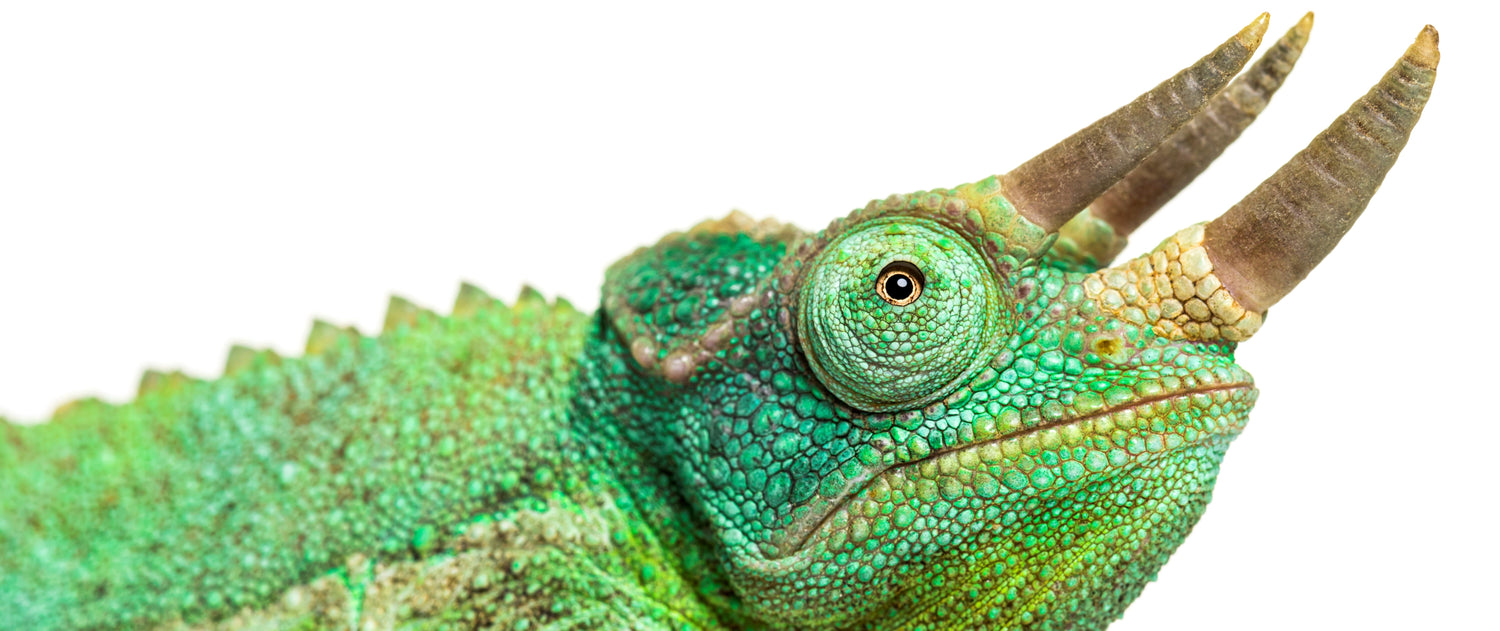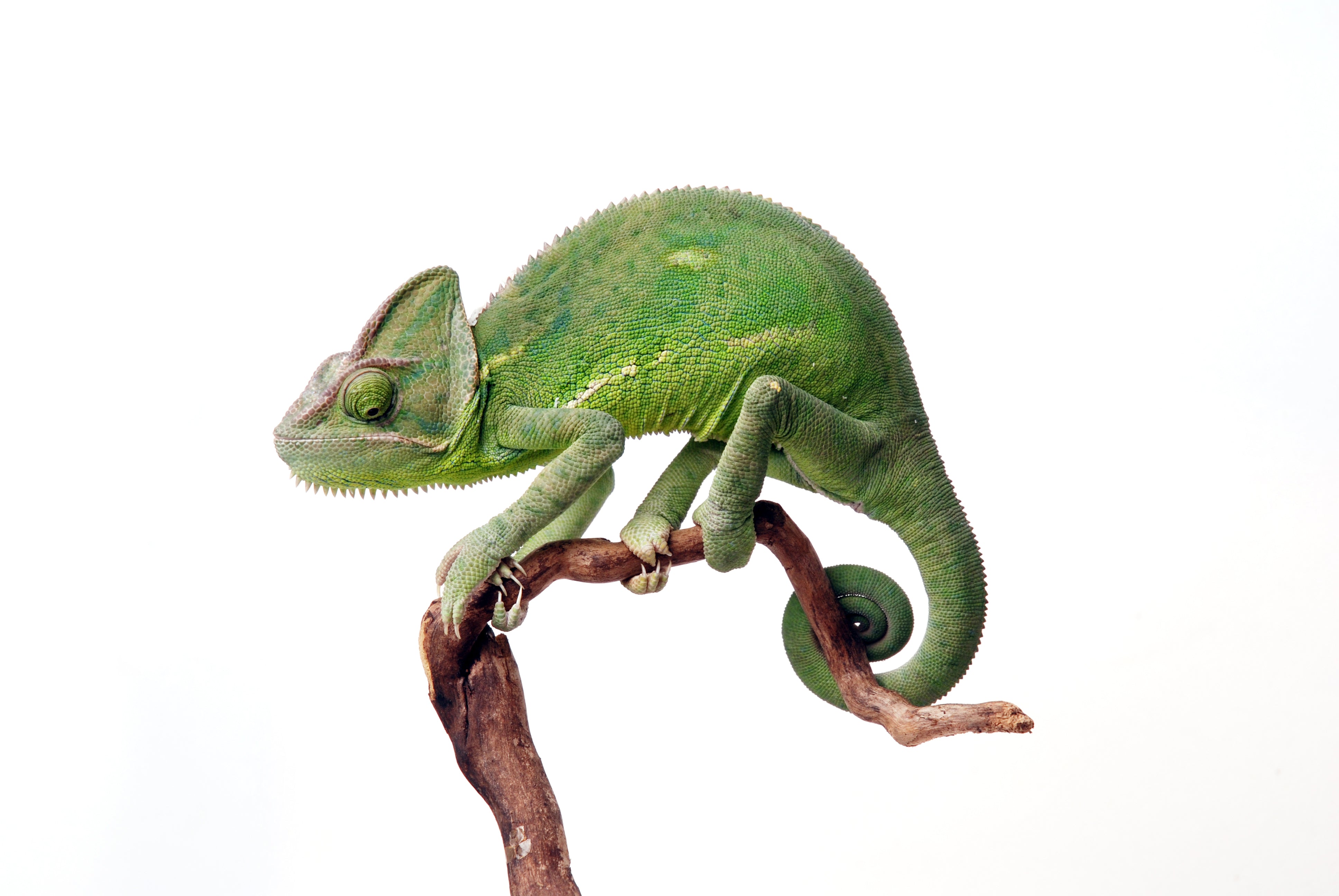The Jackon's Chameleon is native to woodland and forested areas of South Central Kenya and Northern Tanzania. The males are easily identified by the three horn-like appendages protruding from their face that makes them unique from any other species of Chameleon. At the same time, the females generally lack three horns; they typically have a single small horn or only small traces of the rostral horn. The two genders also differ in appearance by color, with the males ranging from dark green, with a turquoise head and bright yellow patches on their flanks. The females tend to be a lighter green, sometimes even red.
As insectivores Jackson's Chameleons eat bugs, there is a wide variety available for them to eat. In the wild, they are opportunistic hunters that will pretty much eat anything that they come across. Primarily catching flying insects to eat them, they eat a range of flies, bees, wasps, and small beetles. Being humans that do not have easy access to what these reptiles would usually eat in their natural environment, we work with what we can to make their captive diet resemble their natural diet as closely as possible. Various factors come into play when choosing the correct diet for your reptile; chameleons need a diverse mix of insects to meet their nutritional needs and to keep them healthy. When it comes to a staple diet for your pet, while there are foods that are better or worse, the term staple can be misleading as it implies there is one food they can eat every day and be healthy when this is not the case, all reptiles do best with variety in their diet. First, we will explore the best staple foods for your Chameleon that can be fed every day.
How Often Do I Feed My Chameleon?
- Babies (1-3 months) - Need to eat as much as they can twice per day, as they are growing fast they need the protein and will burn through it quickly as they use it for their growth. However, ensure that what they are offered is x-small insects only. Do not provide them insects that are bigger than the space between the eyes for most live feeders. For some, this rule can be relaxed; for example, in the case of hornworms or silkworms, they can manage slightly bigger. The best staples for them are extra small dubia roaches and black soldier fly larvae. Pinhead crickets can also be used, and variety is always crucial, so use a few different feeders at all times.
- Juveniles (3-6 months) - Can be fed slightly larger insects, extra small will now be too small, so you will want to offer them small dubia roaches, black soldier fly larvae, small crickets, and other small size insects. They should now be eating around 10-15 small dubia roaches or the equivalent of other small size bugs per day.
- Sub-adults (6-12 months) - You can now offer your chameleon medium bugs, they should be eating 8-12 medium dubia roaches or the equivalent per day. Always provide a variety of insects, and you can mix in some treat bugs from time to time to keep them interested.
- Adults (over 12 months) - Adults can have large insects, so you can now give them 6-8 large dubia roaches or the equivalent per day. The smaller the insect, the more they will need to eat, so in the case of BSFL, for example, you will need to give them more like 20-25 per day if feeding BSFL solely. Always remember they need a variety in their diet to keep them interested and to provide the range of nutrients that they need. 6-8 medium or large crickets every other day
Everyday Insects
- Dubia Roaches (and other roaches)
- Nutrigrubs (Black Soldier Fly Larvae)
- Black Soldier Flies
- Hornworms
- Silkworms
- Snails
- Stick insects
Treat Insects
Never feed your Chameleon wild-caught bugs, yes they eat wild insects in their natural environment, but where we live is quite different to their natural homes with different flora and fauna. Along with the fact that we have pollutants and pesticides that are present, wild bugs can be contaminated with these and also be infected with diseases or parasites that are dangerous for your pet.
Bugs to Avoid
There are also certain bugs that for various reasons can be very bad for your Chameleon, some are toxic others may be harmful in other ways, but you should do your utmost to prevent your pet from ingesting these insects:
- Fireflies (lightning bugs)
- Ladybugs
- Centipede
- Spiders
- Monarch butterflies and caterpillars
- Ants (not all but the bites of some can cause severe allergic reactions)
Supplementation
As with most insectivorous reptiles, Jackson's Chameleons need to have extra vitamins and minerals added to their diet to stay healthy. Even in the wild, getting enough calcium in their diet can be a problem due to the high phosphorous:calcium ration of more feeder insects, so it is up to you to add a little extra to give them what they need. The main supplements you will need are regular calcium powder without vitamin D3 added, calcium powder with D3 added, and also a multivitamin supplement. Calcium is required to support and maintain healthy bone growth and development; vitamin D3 is used by the body to help absorb the calcium. Their UVB will help them to produce their own vitamin D3, but they should still be given a little extra to ensure they are getting enough. A multivitamin helps to add a balanced range of vitamins and minerals they may be missing with an insectivorous diet. All ages of your Chameleon will need these on a schedule which will look like this:
- Day 1 - Calcium
- Day 2 - Calcium plus D3
- Day 3 - Calcium
- Day 4 - Calcium plus D3
- Day 5 - Calcium
- Day 6 - Multivitamin
- Day 7 - No supplement
To administer the supplement, simply put your choice of feeder insects into a baggie, add a pinch of the supplement being used that day, and shake the bag up to coat the insects evenly. Then feed the insects to your Chameleon as per usual. Do not add too much supplement; you're not looking for powdered donuts, just a pinch for alight coating will do. Here are our recommended supplement products for you to choose from:
- Repti-Calcium without vitamin D3
- Exo-Terra Calcium Powder without D3
- Exo-Terra Calcium Powder Plus D3
- Zoo Med Calcium Powder Plus D3
- Exo-Terra Multivitamin Powder
- Rep-Cal Multivitamin Powder
Gut-loading Your Feeder Insects
Gut-loading your live insects is the process of passing on essential nutrients through your feeder insects onto your pet chameleon by feeding your bugs a nutritious diet. This will make them full of vitamins and minerals, which will then be absorbed by your pet once they have been eaten. To properly gut-load your feeders, you can use commercial products that have been designed for this purpose, or you can simply feed them salad items that would be safe for your pet to eat themselves. Think of it as a way of tricking your Chameleon into eating stuff they usually wouldn't touch giving it to their bugs instead. To use dubia roaches as an example, your roaches can be fed with a gut-loading product or some healthy salad items for a few days, and then you can feed them to your pet as one of their daily meals.
Here are some products we recommend that can be used for gut-loading your feeder insects:
Here are some safe salad items that can also be used for gut-loading your feeders:
Bee pollen is another item that can also be used on your bugs as an appetite stimulant but also for added health benefits. Reptiles tend to be attracted to the sweet smell so it can be used as a tool to help fussy eaters to eat their bugs by sprinkling the powder on them, it can also be fed to insects as part of the gut-loading process. it has many health benefits by providing vitamins and minerals to your Chameleon and is an often underused item.
Hydration - Giving Your Chameleon Water
Since chameleons pretty much flat out refuse to drink still water from a bowl or dish, the only way to give them water is to try to mimic the way they way drink in their natural environment. This involves misting their enclosure, including the walls and the leaves with water multiple times per day, to ensure that there are always droplets available for them to drink should they need to. You can choose to do this by hand if you have the time, but the best way to do so is to use a "ripped" to do this automatically. You always want to make sure that the water you give them is clean and treated, so using a product to dechlorinate the water is a good idea. See below for some products that could help you to offer water to your Chameleon:




Leave a comment
All comments are moderated before being published.
This site is protected by hCaptcha and the hCaptcha Privacy Policy and Terms of Service apply.